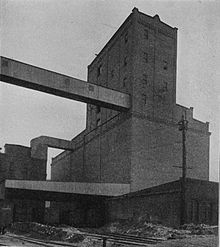
A grain elevator is a facility designed to stockpile or store grain. In the grain trade, the term "grain elevator" also describes a tower containing a bucket elevator or a pneumatic conveyor, which scoops up grain from a lower level and deposits it in a silo or other storage facility.

The Hennepin Avenue Bridge is the structure that carries Hennepin County State Aid Highway 52, Hennepin Avenue, across the Mississippi River in Minneapolis, Minnesota, at Nicollet Island. Officially, it is the Father Louis Hennepin Bridge, in honor of the 17th-century explorer Louis Hennepin, who was the first European to see the Saint Anthony Falls, a short distance downriver. Two of the three previous structures have been suspension bridges, while a third—which existed nearly a century—was composed of steel arch spans. The original crossing, which opened as a toll bridge on January 23, 1855, is believed to have been the first permanent span across the Mississippi at any point. Other bridges were completed in 1876, 1891, and most recently 1990. Today, the bridge's main span is 190 metres (620 ft) in length.

William de la Barre was an Austrian Empire-born civil engineer who developed a new process for milling wheat into flour, using energy-saving steel rollers at the Washburn-Crosby Mills in Minneapolis, and later served as chief engineer for the first hydroelectric power station built in the United States, at Saint Anthony Falls, also in Minneapolis.

The Pillsbury A-Mill is a former flour mill located on the east bank of the Mississippi River in Minneapolis, Minnesota. It was the world's largest flour mill for 40 years. Completed in 1881, it was owned by the Pillsbury Company and operated two of the most powerful direct-drive waterwheels ever built, each capable of generating 1,200 horsepower . In 1901 one of the turbines was replaced with a 2,500 horsepower one. Both the mill and its headrace tunnel are contributing resources to the St. Anthony Falls Historic District, which is listed on the National Register of Historic Places. The mill is also independently on the NRHP. The mill was named a National Historic Landmark in 1966 and has since been converted into the A-Mill Artist Lofts.
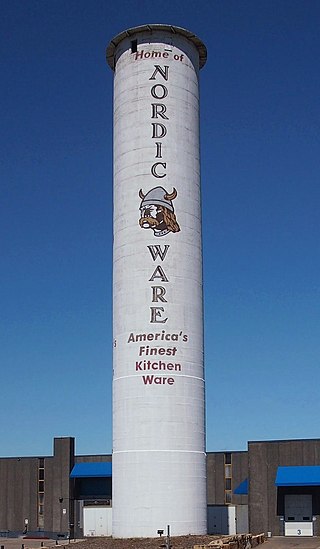
The Peavey–Haglin Experimental Concrete Grain Elevator is the world's first known cylindrical concrete grain elevator. It was built from 1899 to 1900 in St. Louis Park, Minnesota, United States, as an experiment to prove the design was viable. It was an improvement on wooden elevators that were continually at risk of catching fire or even exploding. Its cylindrical concrete design became the industry standard in the United States, revolutionizing grain storage practices. After its initial experiments, the Peavey–Haglin Elevator was never again used to store grain. Since the late 1960s it has been maintained on the grounds of the Nordic Ware company and is painted with their name and logo.

The August Schell Brewing Company is a brewing company in New Ulm, Minnesota, that was founded by German immigrant August Schell in 1860. It is the second oldest family-owned brewery in America and became the oldest and largest brewery in Minnesota when the company bought the Grain Belt rights in 2002. In September 2010, the brewery celebrated its 150th anniversary with a two-day festival. Every year, Schell's also celebrates traditional German holidays with Bock Fest and Oktoberfest. The current brewery is owned and operated by the August Schell Brewing Company, a Minnesota corporation that was incorporated in 1902.

Phelps Mill is a flour mill in Otter Tail County, Minnesota, United States, on the Otter Tail River. The mill was built in 1888–1889 by William E. Thomas, a local entrepreneur who owned a flour and feed business in Fergus Falls. During that time, wheat was a high-demand crop, and nearly one thousand flour mills were in operation throughout Minnesota. Thomas began constructing a wooden dam on the river in the spring of 1888, although the dam was prone to leakage and had to be shored up with sandbags, dirt, gravel, and other materials. The mill itself was built by Royal Powers, who built and framed the mill without using blueprints. He was able to keep the entire plan within his head and did not even have to mark out the lumber he was cutting.

Minneapolis is the largest city by population in the U.S. state of Minnesota, and the county seat of Hennepin County. The origin and growth of the city was spurred by the proximity of Fort Snelling, the first major United States military presence in the area, and by its location on Saint Anthony Falls, which provided power for sawmills and flour mills.
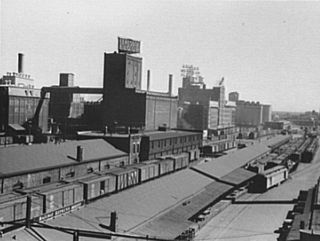
Northwestern Consolidated Milling Company was an American flour milling company that operated about one-quarter of the mills in Minneapolis, Minnesota, when the city was the flour milling capital of the world. Formed as a business entity, Northwestern produced flour for the half-century between 1891 and 1953, when its A Mill was converted to storage and light manufacturing. At its founding, Northwestern was the city's and the world's second-largest flour milling company after Pillsbury, with what is today General Mills a close third. The company became one of three constituents of a Minneapolis oligopoly that owned almost nine percent of the country's flour and grist production and products by 1905. This occurred as a result of their attempt at a United States monopoly.

The North Star Woolen Mill, now the North Star Lofts, is a building in downtown Minneapolis, Minnesota, United States. The building, located in the St. Anthony Falls Historic District, was originally a textile mill for the North Star Woolen Company. The mill was built in 1864 by W.W. Eastman and Paris Gibson on the west side of the west side canal. High quality wool blankets, scarves, flannels, and yarns were manufactured at the facility and it became the nation's largest manufacturer of wool blankets by 1925.

The following are all the contributing resources to the Saint Anthony Falls Historic District in Minneapolis, Minnesota, United States. The District is listed on the National Register of Historic Places, thus these properties are on the NRHP. The "period of significance" of the District was 1858–1941. The district's archaeological record is considered to be one of the most-endangered historic sites in Minnesota.

Mill City Museum is located in the ruins of the Washburn "A" Mill next to Mill Ruins Park on the banks of the Mississippi River in Minneapolis. The museum, an entity of the Minnesota Historical Society that opened in 2003, focuses on the founding and growth of Minneapolis, especially flour milling and the other industries that used hydropower from Saint Anthony Falls. The mill complex that the museum is within, dates from the 1870s and is listed on the National Register of Historic Places. It is also part of the St. Anthony Falls Historic District and within the Mississippi National River and Recreation Area.
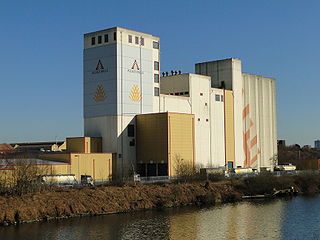
A gristmill grinds cereal grain into flour and middlings. The term can refer to either the grinding mechanism or the building that holds it. Grist is grain that has been separated from its chaff in preparation for grinding.
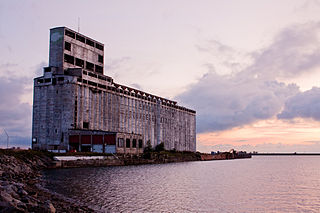
The Cargill Pool Elevator is a grain storage facility in Buffalo harbor built in the 1920s and previously named the Saskatchewan Cooperative Elevator. The elevator is the only grain elevator in Buffalo that is located directly adjacent to Lake Erie.

The Portland General Electric Company Station "L" Group in southeast Portland in the U.S. state of Oregon was a cluster of six industrial buildings listed on the National Register of Historic Places. Built between 1910 and 1929 by Portland General Electric (PGE), it was added to the register in 1985. In 1986, PGE gave Station L and 18.5 acres (7.5 ha) of land to the Oregon Museum of Science and Industry (OMSI). The Station L turbine is a central feature of OMSI's Turbine Hall. The complex was listed on the National Register in 1985, and was delisted in 2020.

The Great Northern Elevator was a grain storage facility at 250 Ganson Street in Buffalo, New York. The elevator was located on the City Ship Canal and at the time of its completion in 1897, the elevator was the world's largest. The elevator was the first to employ cylindrical steel bins for grain storage, and also one of the first to run on electricity. The brick curtain wall did not support the bins or the working house and was designed as weatherproofing only.

American Grain Complex, also known as "The American", Russell-Miller Milling Co. Elevator, and Peavey Co. Elevator, is a historic grain elevator and flour milling complex located in South Buffalo, Buffalo, Erie County, New York. The complex consists of three contributing buildings and two contributing structures. They are the Elevator Building, Flour Building (1906-1924), office building, Moveable Marine Tower, and railroad tracks. The Elevator Building consists of the mainhouse, workhouse, and fixed marine tower, all built in 1905–1906, and an annex constructed in 1931. The complex was last owned by ConAgra Foods, who closed the elevator and mill in June 2001.

The International Smelting and Refining Company was a subsidiary of Anaconda Copper that operated primarily out of the International Smelter near Tooele, Utah. The International Smelter began operation in 1910 as a copper producer handling ores from Bingham Canyon and was expanded into a lead smelting operation in 1912. Copper smelting finished at International in 1946, and the lead smelter shut down in January 1972. The closure of the smelter would lead to the associated Tooele Valley Railway to be shut down ten years later in 1982. The company also handled several other Anaconda owned interests. After the shut down of several of the International Smelting sites, environmental reclamation has been performed by Anaconda Copper's successor company ARCO and the EPA Superfund program.
St. Anthony Falls in Minneapolis, Minnesota, is the only natural falls on the Mississippi River. Since almost the beginning of settlement in the area by European descendants, the St. Anthony Falls have been used for waterpower. The first allowed settlers were at Ft. Snelling, where construction began in 1820. A sawmill was operating 1821 and a flour mill in 1823. As soon as the land at the sides of the falls became available it was purchased with the intent of using the waterpower of the falls. First lumber mills covered the falls, cutting lumber floated down the Mississippi. After 1870 flour mills started to dominate the area. From 1880 to 1930 the area was the number one flour producer in the US. In later years, some of the power came from steam, but in 1923 half of the waterpower used was for flour milling. Other industries have also used the waterpower.

